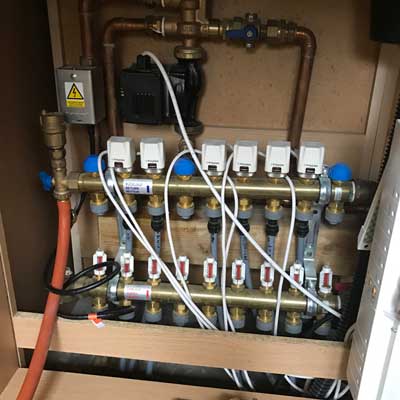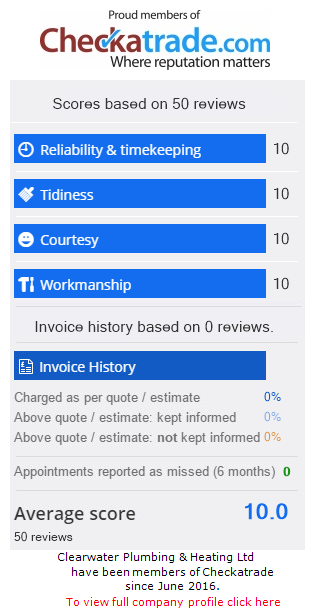Underfloor Heating Chelmsford
Call 01245 830 015
Welcome to Clearwater Plumbing. We Install, Service and Repair Underfloor Heating systems in Chelmsford.
- Installation
- Service & Repair
- Wet & Electric Systems
- Gas Safe Registered Engineers
- Full public liability insurance
- Free no-obligation surveys and quotes

Installation
Underfloor heating installation has become a popular method of heating homes. It involves installing a system beneath the floor surface that warms the space from the ground up, providing comfort, efficiency, efficiency and even heat distribution.
There are two forms of underfloor heating systems: wet and electric. We fit both types of underfloor heating systems.
Wet Systems
Wet underfloor heating, also known as a hydronic system, involves the installation of a network of pipes under the floor, through which warm water is circulated. A Boiler typically heats this water. The heat from the water radiates through the floor, warming the room evenly and efficiently.
Wet underfloor heating is often chosen for its efficiency in heating large spaces and compatibility with various renewable energy sources. The installation process is more complex and invasive than electric systems, often involving significant alterations to the floor structure, such as adding a layer of screed to ensure even heat distribution and protect the pipes.
Electric Systems
Electric underfloor heating uses electrical cables or mats installed directly under the floor. When electricity passes through these cables or mats, they generate heat transferred to the floor above. This type of system is particularly well-suited for retrofitting existing buildings due to its relatively simple and non-invasive installation process.
Electric underfloor heating works well for smaller areas or supplemental heating in specific rooms like bathrooms or kitchens. While it heats up quicker and is easier to install than wet systems, it tends to be more expensive in terms of running costs, especially if used as the main heat source in large areas.
Wet Or Electric Underfloor Heating?
When deciding between wet and electric underfloor heating systems, several factors should be considered: installation, cost, efficiency, and suitability for your property. Both systems have their advantages and drawbacks. During a free survey, one of our engineers will review each system’s pros and cons and establish which is best for your home and situation.
Here is a comparison of wet and electric underfloor heating.
Wet Underfloor Heating
Installation:
- Best installed during the construction of a new building or home renovations.
- Involves laying pipes under the floor, through which warm water is circulated from a Boiler or other heat source.
- Requires a more in-depth installation process, often including laying screed over the pipes.
Cost:
- Generally, it is more expensive to install due to the complexity of the system and the materials required.
- Running costs are lower when compared to electric underfloor heating.
Efficiency:
- Wet systems are more efficient for heating larger areas and are a better choice for whole-house heating.
- Can run at a lower temperature while still providing effective heating, which is more energy-efficient.
Suitability:
- Ideal for new builds or major refurbishments such as extensions.
- Can be combined with renewable energy sources for eco-friendly heating.
- Suitable for medium and large areas.
Electric Underfloor Heating
Installation:
- Easier and less costly to install, making it suitable for retrofitting existing homes.
- Involves laying electric heating mats or cables beneath the floor surface.
- Typically, it does not require significant alterations to existing floor structures.
Cost:
- Lower installation costs compared to wet systems.
- The cost of electricity can make it more expensive to operate, especially if used as the main heating source for a large area.
Efficiency:
- Heats quickly, making it efficient for short-term use in bathrooms or kitchens.
- Best suited for smaller areas or extra heating.
Suitability:
- Ideal for renovations, smaller homes, or for adding extra heating to specific rooms.
- It can be installed under various types of flooring without significant alterations.
- More suitable for zonal heating rather than whole-house heating.
Wet & Electric Underfloor Heating Compared
Here’s how wet and electric underfloor heating compare:
Installation Complexity
Wet systems are more complex and invasive, making them better suited for new builds or major refurbishments. Electric systems are simpler and less disruptive, ideal for retrofits.
Operational Cost
Wet systems have lower running costs but higher installation costs. Electric systems have lower installation costs but are more expensive to run (depending on the electricity prices and usage)
Heat Distribution & Efficiency
Wet systems are more efficient for larger areas and provide a more consistent heat distribution. Electric systems are suitable for smaller areas or targeted heating.
Flexibility & Control
Electric systems offer more flexibility and are easier to control, especially for zonal heating. Wet systems can also be ‘zoned’.
Choosing between wet and electric underfloor heating depends on your needs, budget, and heating requirements. A wet system might be more suitable for whole-house heating in new constructions or major renovations. An electric system could be the better choice for targeted heating in specific areas or for ease of installation in existing properties.
How A Free Survey Will Benefit You
A free, no-obligation survey and quote undertaken by one of our engineers determines the most suitable underfloor heating system for your home and specific needs.
During this survey, a professional assesses various aspects of your property, including room sizes, floor construction, existing insulation levels, and overall heating requirements. This assessment allows them to understand your space’s unique characteristics and constraints, such as the feasibility of installing a wet or electric system, the need for any subfloor modifications, and the best layout for efficient heat distribution.
Additionally, they can identify any potential challenges or additional work that might be required, such as upgrading the existing electrical system for electric underfloor heating or integrating a Boiler for a hydronic system.
Based on this detailed analysis, our engineers provide a tailored quote outlining the recommended underfloor heating type, the installation work scope, and the associated costs. This personalised approach ensures that you receive an underfloor heating system that is efficient and effective and aligns with your budget and the practical considerations of your home and heating requirements.
Service & Repairs
We offer underfloor heating service and repairs. At the same time, generally, reliable and low maintenance, underfloor heating systems may occasionally require servicing and repairs to ensure optimal performance.
Servicing includes checking the system’s components, such as the thermostats, heating elements, boiler and pipework, for leaks or blockages in the case of hydronic systems.
For electric underfloor heating, inspecting the electrical connections and mats or cables for any damage is essential. Repairs might be needed if there are issues like uneven heating, thermostat malfunctions, or visible damage to the system.
Professional servicing is recommended at least once a year to maintain efficiency and extend the system’s lifespan. Timely repairs and maintenance ensure the system functions effectively and prevent more significant and costly issues down the line.
Contact Us For A Free No-Obligation Quote
If you’re interested in installing an underfloor heating system and would like a free no-obligation survey and quote or require a service or repair, please call us on 01245 830 015








